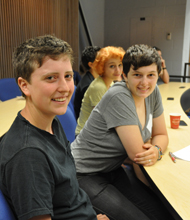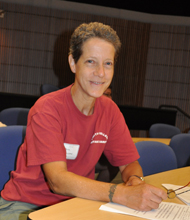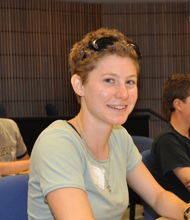Smith College Both the Site and Subject of Summer Undergraduate Research
NORTHAMPTON, Mass. – The jitters among undergraduates presenting the progress of summer research on a recent Friday was evident in a smattering of nervous laughter, occasional lengthy pause or offered apology.
But nothing diminished the impact of nearly 100 students sharing the trials and tribulations of research as challenging and varied as the “Absorption of Uncharged Polysaccharides to Protein-Treated Silicon-Based Surfaces” to the “Theory of Mind Understanding in Individuals with Autism Spectrum Disorders.”
 |
JenniferSadler '13
KaitlinSomers '12 |
This is the 43rd year that Smith College has offered its Summer Undergraduate Research Fellowships (SURF) a program that invites students not only from Smith, but Amherst, Mt. Holyoke and Hampshire colleges, and the University of Massachusetts Amherst, to do funded research here.
It is an opportunity for students to investigate a subject that interests them with less faculty direction than is typical in the academic year and with less certainty as to what the outcome will be, according to Denise McKahn, assistant professor of engineering.
 |
June Lukuyu '13 |
And, that is a critical step in the development of the students as researchers who can investigate, present and publish findings that are expected or surprising.
This summer, several students are leading research projects that focus on Smith. June Lukuyu ’13 is analyzing the efficiency of the solar hot water system on the roof of McConnell Hall. Jennifer Sadler ’13 and Kaitlin Somers ’12 are charting the steps to developing a smarter power grid at Smith. Read about three other projects below.
Taking Aim at Invaders—Removing Non-Native Plants Along the Mill River
Smith is waging a battle with invaders on the banks of Mill River that needs to be hit with a lot of green – as in plants, according to a team of students that have taken up the charge as Summer Undergraduate Research Fellows.
 |
Angela Oliverio '12 (left)
Brittany Innis '13 |
About a dozen non-native plants have taken over some 80,000 square feet of land stretching north to south along the banks of Paradise Pond, successfully shutting out native plants, said Brittany Innis ’13 and Angela Oliverio ’12.
Innis and Oliverio are among the first string of defenders of the land this summer, and presented their research “Mill River Invasives Mitigation,” Friday July 16, as SURF students.
The non-native species recently caught the attention of the Northampton Conservation Commission and the college during planning for the construction of the synthetic athletic turf field in that area – a project now under way.
Smith was asked to remove about a half-dozen identified invasive species as part of the project. Innis and Oliverio have since begun to expand the list as they come across others.
This summer, the pair began tagging all the invasive species and set up test plots to determine how best to remove them. Faculty members representing a variety of disciplines at Smith and the new Center for the Environment, Ecological Design, and Sustainability (CEEDS), are expected to continue the students’ work during the academic year.
Among the most egregious offenders is the Japanese Knotweed, said Innis, which is listed by the World Conservation Union as one of the world's 100 worst invasive species. According to literature, removing the Japanese Knotweed is extremely difficult due to the depth of its roots, and the plant is resilient to cutting, vigorously re-sprouting from the roots.
Others they are taking aim at: Multiflora Rose, Japanese Barberry, Tartarian honeysuckle, Winged Euonymus, Autumn Olive, Bittersweet, Norway Maple and Euonymus fortunei 'Minimus.’
Given the success of the non-native species, their eventual removal will be evident. “If it looks like we are taking away the forest, we are not,” said Innis. “We are going to replant it with native species.”
Lyman Pond Thirsting for New Water Source
Located next to the Botanic Garden, Lyman Pond captures the attention of passersby with the sculpture of a great blue heron by artist Elliot Offner. Yet it can’t seem to capture the rainwater it desperately needs.
 |
| Elizabeth Gillespie AC |
Now mid-July, the water level is going down and plants are rapidly moving in and choking it, according to Elizabeth Gillespie, an Ada Comstock Scholar who shared the results of her study “Drip, Drip, Drop” Friday as a SURF student.
In the short term, the pond needs to be dredged, said Gillespie. But, in the long term, the pond needs a new, robust source of rainwater to avoid the annual cycle. “The question is where will we get this water,” said Gillespie.
She has been monitoring the pond since February, when engineering consultants hired by Smith determined that the pond holds less than half the water that it should – 155 as compared to 370 cubic yards.
The situation was brought about by an alteration of the drainage system that previously provided rainwater to the pond. In recent years that system was revamped during renovations of the Lyman Plant House.
The college is now evaluating several possible new sources of rainwater for Lyman Pond, including rerouting a storm drain near Lanning Fountain, rainwater off of Chapin House, rainwater off of the Lyman Plant House or water from the basement of the Campus Center, where a sump pump is in constant use.
“We are looking for natural sources so not have to tap into the city water system,” said Gillespie. “This project will go on long after me.”
Covering Old Ground with New Technology
University of Massachusetts student Erin Kassis ’11 is digging into the geological history of the region to uncover the types of soil beneath the Smith campus. Once she has the information, Kassis plans to create a comprehensive GIS map.
 |
| Erin Kassis 2011 UMass |
“Smith’s campus is a hugely interesting place to do this,” said Kassis, who shared her research Friday as a SURF student. ”When the glaciers receded, different layers of soil formed.”
Kassis’ research has taken her to the archives of construction plans in Facilities Management, the Smith Department of Geology and state and federal government environmental records. The next step will be to take soil samples.
The project offers several benefits, according to Kassis. First, the information can inform construction projects. Different types of soil often have an impact on the way a building is constructed or the level of support it needs.
When the college cut into the side of the hill to construct the Lyman Plant house, for example, builders discovered clay. Sand is beneath the Campus Center, she added.
Second, the information will benefit the landscapers.
The information will inform where to locate various plantings on campus because the life and death of plantings is often connected to the type of soil in which they are located. The information may also hold answers to one unresolved question—the ongoing loss of Sugar Maple trees in this area, she said.
“At the end of the summer we’ll have a database that other students and faculty can continue to add to,” said Kassis.
Photos by Roberge |























